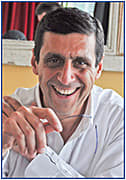Industry Insider is a timely chat with an ophthalmic industry thought leader.
After graduating from The Hebrew University of Jerusalem in 1993, Marc Abitbol, PhD, helped introduce wavefront diagnostic technology to the ophthalmic field with his first company, Visionix. Since then, Visionix has become one of several subsidiaries operated by Luneau Technology, where Dr. Abitbol serves as CEO.
Ophthalmology Management: How did you found Visionix?
Marc Abitbol, PhD: Well, it’s not a typical story. I did my PhD in applied physics, studying wavefront technology. My research was actually funded by the Reagan administration. This was in the 1980s in the time period of President Reagan’s “Star Wars” defense initiative. The wavefront technology I studied could be used to control laser beams through the atmosphere, making them effective at destroying Russian satellites. The first time I visited the United States was actually to give a lecture on this research.
Once I finished my PhD program, I wanted to find other applications for this technology. A good friend, who was more market savvy than me, suggested using it to measure aberrations in eyes. That got me interested in ophthalmology and led to the founding of Visionix in 1994. In 2003, we acquired the company Luneau, which brought us broader access to European markets. By 2005, we had set up Luneau as the holding company of our business.
OM: How has ophthalmic wavefront technology changed over the years?
MA: Fifteen years ago, only expensive, complicated wavefront products were available, and we were the first to offer the technology at a reasonable price. The spread of wavefront technology went from refractive laser surgery to high-end diagnostic medical devices, and now it is being used to make customized scleral lenses to limit the impact of keratoconus. I believe the technology will only become more popular as time goes on.
OM: What products is Luneau currently working on?
MA: One of the main products we are working on now is Eye Refract, a phoropter that uses wavefront to take automatic measurements of a patient’s eye while they are looking at an eye chart or similar display, thereby adding an objective result to the process. We expect the Eye Refract to launch in the U.S. in late 2018 to early 2019.
We also recently launched the VX130 Multi-function Anterior Segment Analyzer, which combines in one instrument three measurement technologies: Shack-Hartman Wavefront Aberrometry, multi-slit Scheimpflug imaging for anterior and posterior corneal measurements plus Placido ring corneal topography.
OM: Your company has grown considerably in the last 20 years. What are some of the challenges you’ve faced in that time?
MA: When we started 20 years ago, we only had about four people working for Visionix. Today, at Luneau, we have around 560 employees internationally. But, around 2005, the entire company almost folded. At that time, there was conflict among the company’s financiers and management about the direction the company should head.
As a result, we were being pushed in too many directions and there was more fighting than business being conducted. The lesson we learned is that, as your company becomes bigger, you need to be more disciplined.
Since that time, we have had a very good relationship with our investors, who are supporting us organically in our growth. OM









